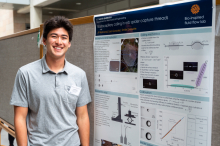
Major:
University:
Mentor(s):
Faculty Sponsor(s):
Faculty Sponsor's Department(s):
Project Title:
Project Description:
Spiders have lived on Earth for over 400 million years, before even the dinosaurs, and their silk is among the most studied biological materials due to its incredible strength and toughness. Spider webs have evolved to be exceptionally effective at capturing and retaining prey. A typical spider web is composed of many different types of silk, each designed for a specific purpose. The capture thread is composed of a soft, extensible silk thread, and a coating of sticky glue droplets which adhere prey to the web. The elastocapillary interaction between the glue droplets and the silk causes the thread to buckle and then coil within the glue droplets as it is compressed, while the surface tension of the droplets keep the fiber taut. This means that the capture thread can be compressed far beyond the length at which an uncoated fiber would begin to sag while remaining taut. It is hypothesized that this morphology evolved to prevent the web from tangling with itself during wind loading or insect impact. To study the mechanics of the capture thread, we use a custom setup to conduct tensile and compressive tests on a single thread while imaging the coiling and measuring the sub-micro-Newton forces within the thread with micropipette force sensing. We test both biological samples collected from spider webs in Nature and a model system composed of TPU fibers and silicone oil or PEO droplets. This set-up will allow us to explore the key parameters that govern the dynamic of the thread/glue interaction such as the droplet surface tension, viscosity and viscoelasticity, and the strain rate of the test. The results of this study will provide a deeper understanding of how spider webs work and could be used to create our own solid-liquid hybrid metamaterials.
